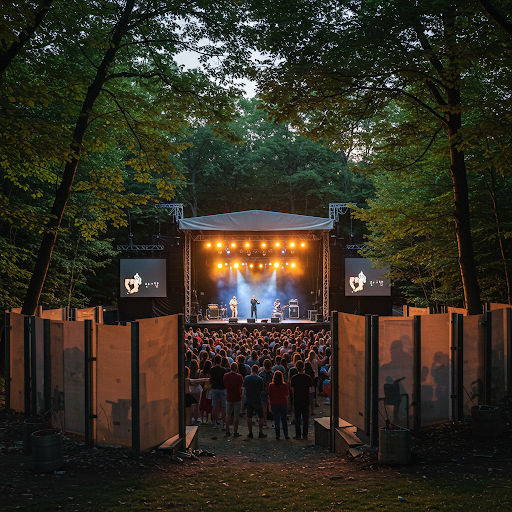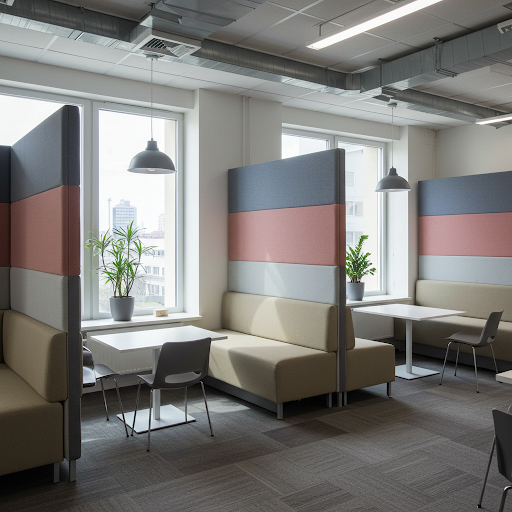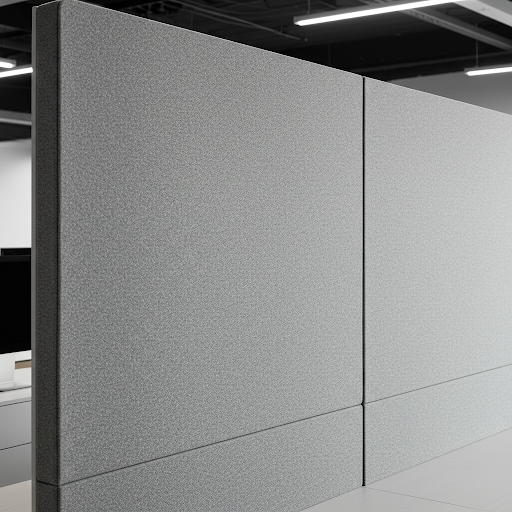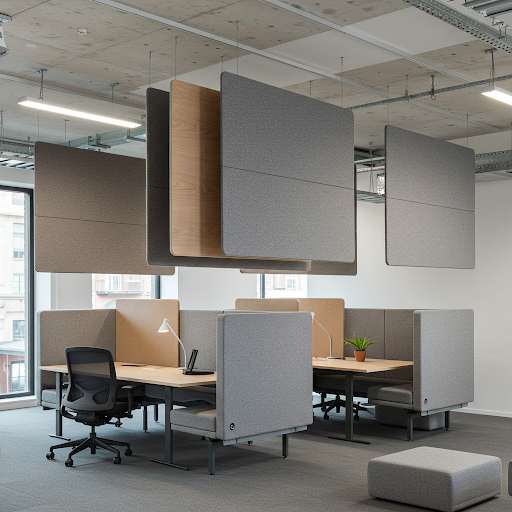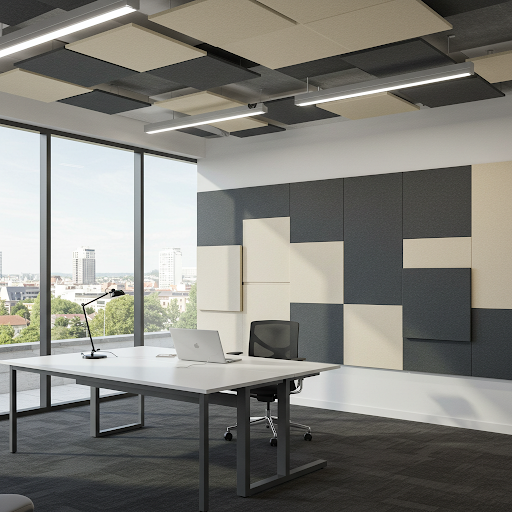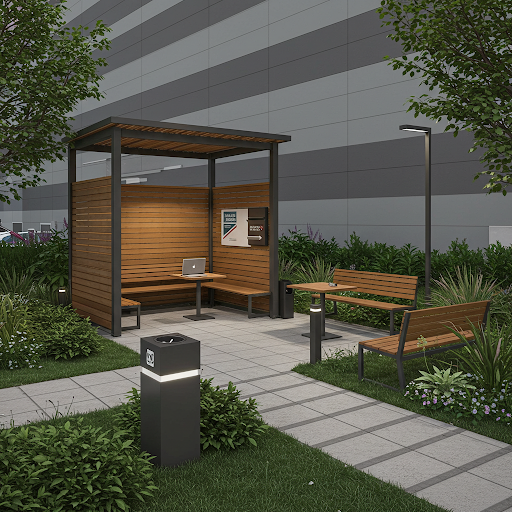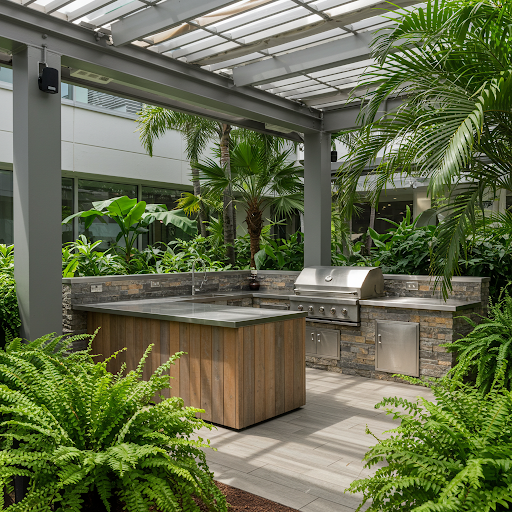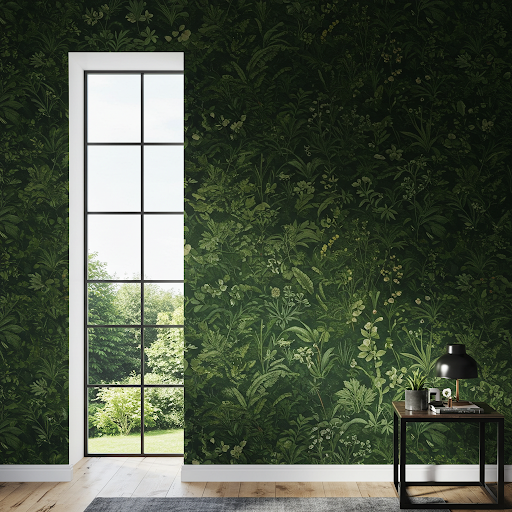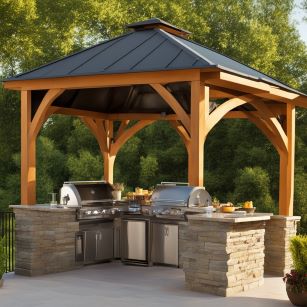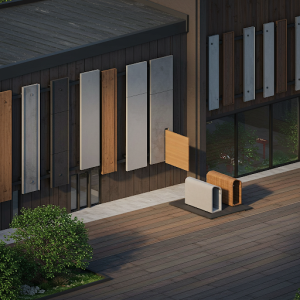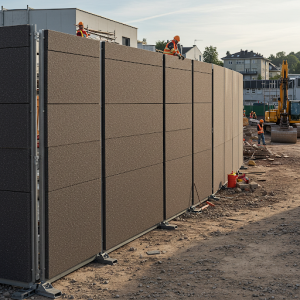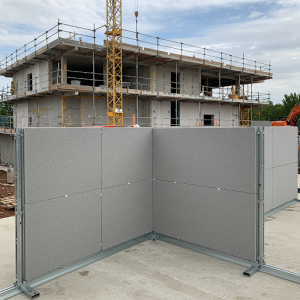Description

Outdoor soundproofing becomes essential in various scenarios where unwanted noise disrupts daily life or specific activities. Residences located near busy roadways, airports, or train tracks frequently require soundproofing to mitigate traffic noise. Outdoor entertainment spaces, such as patios or pool areas, may benefit from soundproofing to enhance enjoyment and reduce disturbances to neighbors.
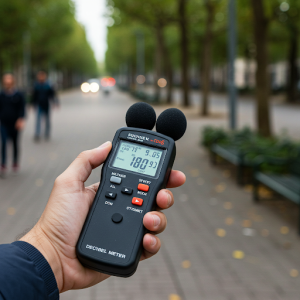
Commercial establishments, like restaurants with outdoor seating, can utilize soundproofing to create a more pleasant dining atmosphere. Industrial facilities often necessitate outdoor soundproofing to comply with noise regulations and minimize environmental impact.
Additionally, outdoor music venues or event spaces require soundproofing to control sound levels and prevent pollution in surrounding areas. Any situation where excessive outdoor noise interferes with comfort, productivity, or legal requirements can necessitate soundproofing measures.
The written and unwritten laws in Kenya concerning soundproofing
Kenya’s soundproofing regulations are primarily embedded within the Environmental Management and Coordination Act (EMCA). The National Environment Management Authority (NEMA) enforces noise pollution control, setting permissible noise levels based on land use. Specific guidelines are found in the Noise and Excessive Vibration Pollution Control Regulations, 2009. These regulations dictate acceptable decibel limits for residential, commercial, and industrial areas, with penalties for non-compliance. Construction, entertainment venues, and industrial operations must adhere to these standards, requiring soundproofing measures to mitigate excessive noise.
Outdoor soundproofing site analysis
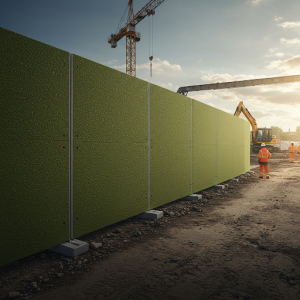
Conducting an outdoor soundproofing site analysis involves a systematic approach to understanding the existing sound environment. Begin by identifying and documenting all noise sources, noting their intensity, audio frequency, and duration. This includes traffic, machinery, human activity, and environmental sounds.
Next, map the sound propagation, considering the terrain, existing structures, and vegetation, as these factors significantly influence sound travel. Measure the ambient noise levels at various points on the site, using a sound level meter, to establish a baseline. Analyze the site’s topography and existing barriers, as elevation changes and solid structures can block or redirect sound. Evaluate the potential impact of weather conditions, as wind and temperature can alter sound propagation.
Finally, consider the desired level of noise reduction and the intended use of the outdoor space, to determine the most effective soundproofing strategies.
The material we use to insulate ourselves from the notice to others
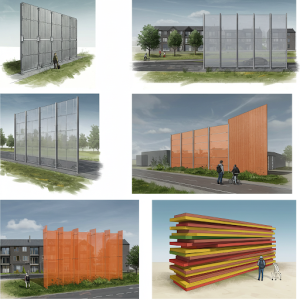
When you decide to reduce the noise level on your terrace and begin researching “outdoor soundproofing systems”, several somewhat confusing concepts arise. Sound insulation of a space is not the same as sound absorption of that same space. The first concept refers to the materials and systems we use to insulate ourselves from the noise of others. And the second offers solutions to absorb the noise we generate ourselves in a space.
It’s also important to know that when an acoustic wave encounters an obstacle, it first bounces back, producing what we call an echo. Another portion is absorbed by the material it encounters. And the third portion passes through the material. With all this in mind, outdoor soundproofing consists of finding the best possible materials, or the best set of techniques, to prevent the transmission of acoustic waves from one area to another. This will isolate you from the noise of others.
The main question will be what type of materials will serve our purpose. Sound absorption requires highly porous and lightweight materials such as foam, rock wool, fiberglass, or textiles.
But sound insulation requires a very different nature: dense and rigid materials. Based on these principles, we’ll tell you the challenges of outdoor soundproofing and the most commonly used systems.
Sound-absorbing materials for outdoor soundproofing are very limited. Because they cannot be used for long unless certain conditions are met.
Condition 1: Resistant to UV rays
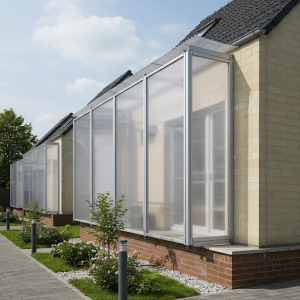
Outdoors, the ultraviolet rays are very strong, and resins are susceptible to deterioration due to ultraviolet rays. In particular, it is best to avoid urethane-based resins. Resins with high weather resistance are polycarbonate, polyethylene, polyvinyl chloride, and melamine (there are others, but these are the most general-purpose ones). Metals can also be used if they have been treated.
Condition 2: Performance can be maintained even when water droplets are applied

There is a good chance that rain or other moisture will get on the sound-absorbing material. Most sound-absorbing materials are porous. So if moisture gets inside, they will often not be able to perform as well as they should. Materials with large pores, such as Miradrain, tend to have less degradation of performance.
Condition 3: Non-combustible materials are preferable
Outdoor soundproofing materials are susceptible to theft, there is always the risk of arson and fire. So it is best to avoid flammable materials as much as possible.
There are other conditions as well. It needs to be sturdy enough to withstand strong winds, easy to install, and heat-resistant enough to maintain its physical properties even when heated by direct Kenyan equatorial sunlight.
Select sound-absorbing materials for outdoor soundproofing
Poal C1 has a proven record in outdoor soundproofing
Poal C1’s outdoor soundproofing success stems from its aluminum plate design. Its widespread use in public spaces validates its effectiveness. Crucially, its sound absorption versatility is achieved through varied construction techniques, adapting to diverse acoustic needs. This feature, coupled with its non-flammable nature, makes it a safe and adaptable solution.
The rigid, plate-like structure efficiently dampens sound waves, reducing noise pollution in outdoor environments. Its durable aluminum composition ensures longevity and resistance to weather conditions, further solidifying its proven record.
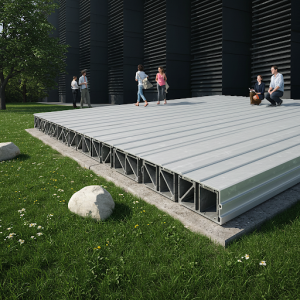
Sound barrier, temporary outdoor soundproofing
Echo Barrier is mainly used as a temporary material at construction sites. You can easily install it on single pipes and can also easily remove it. It is covered with a soft polyvinyl chloride sheet. There is a risk of deterioration after three years or more of use, so please consult before using it.
A height of more than 2 meters would be advisable mainly for two reasons. One, to be higher than the source producing the noise…a road with cars. And second, because it will make the sound pass over our heads, making it less likely that we will be able to hear it.
The fence or barrier must be covered from the bottom up to the height we have considered. Sound waves can pass through any gap or open space.
The density of the barrier is a factor to consider. A dense barrier will prevent waves from passing through. It will also prevent vibrations, which can sometimes be more bothersome than the noise itself. We’ll also consider the thickness. The thicker the barrier, the greater the protection, always keeping in mind the use of higher-density materials.
Sound-absorbing sheet
The sound-absorbing sheet, intended for construction site noise mitigation, shares a similar application with the Echo Barrier. However, it distinguishes itself by utilizing replaceable glass wool as its internal sound-absorbing material. Additionally, this product offers customization, as it is made to order, and its dimensions can be tailored to specific requirements.
Systems to soundproof your home’s terrace
Soundproofing a home terrace presents unique challenges due to its open-air nature. Traditional indoor soundproofing methods are often ineffective outdoors. Weather exposure necessitates durable, water-resistant materials, which are typically less efficient at absorbing sound. Ambient noise from traffic, neighbors, and natural elements complicates achieving significant noise reduction.
Structural limitations of the terrace itself may restrict the addition of heavy soundproofing elements. Creating an aesthetically pleasing and functional space while addressing these acoustic hurdles requires careful planning and specialized materials designed for outdoor conditions, balancing sound control with environmental resilience.
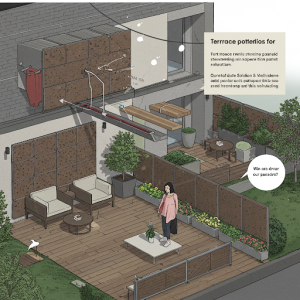 Screens to reduce outdoor noise on the terrace
Screens to reduce outdoor noise on the terrace
Insulating screens or acoustic panels have become an attractive way to reduce noise, not only in work environments but also at home, where they can be used as decorative elements on the wall.
Although in some cases, screens made of fine materials such as fabric are preferred, the most recommended (and most in-demand) screens for their effectiveness are solid ones, made of aluminum, wood, plaster, polyurethane, or polyurethane, to significantly reduce ambient noise. One of their advantages is that they are easy to put up and take down at any time.
Enclosures with Lumon glass curtains to reduce outdoor noise
Lumon glass curtains for terraces are designed to effectively reduce external noise. A result of decades of research, Lumon has developed a safe glazing system capable of drastically reducing the sound coming from outside the home. Installation is always carried out with the technical advice of a highly qualified team, ready to offer the best solution for your terrace based on its layout and other factors that must be taken into account.
Lumon glass curtains also offer a wide panoramic view of the exterior thanks to the elimination of vertical profiles that frame the glass in traditional systems. Thanks to this system, the view onto the terrace is unobstructed, allowing for greater light on the terrace by increasing the glass surface area.
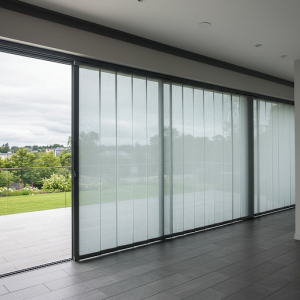
Other advantages of glazing your terrace are that, in addition to reducing noise levels, you also reduce the amount of dirt that gets into your terrace. And if you have small children or pets, the security provided by the enclosures is essential, not to mention the energy savings they offer.
Plants absorb outdoor noise

“Green walls” of properly selected plant species always create a very cozy atmosphere and a special microclimate in the garden. In addition, they protect from wind, street noise, and dust. If the main task is to protect the site from noise, then the hedges should be multi-tiered and consist of two, three, or even four rows of plants. The simplest noise-protective green hedge is two rows of western thuja (thuja is not planted in three rows). But mixed multi-row hedges “dampen” noise much more effectively and look more interesting. Which plants to choose for each tier of a multi-row hedge, we will consider.
Which outdoor plants absorb sound?
Research by scientists has shown that certain types of plants absorb up to 25% of noise, and also disperse and reflect it up to 75%. Coniferous trees capture noise “more actively” and throughout the year. Experiments have shown that spruce, yew, and thuja hedges reduce the sound level by 7 dB, and pine reduces noise by 9 dB.
It has also been established that the following deciduous species are most suitable for noise-absorbing hedges: white acacia, dogwood, hawthorn, Berlin poplar, lilac, maple, small-leaved linden, and common hornbeam. Deciduous plants are capable of reducing the sound level by a maximum of 6 dB.
The upper tier of a sound-absorbing hedge may consist of free-growing trees, such as lindens, hornbeams, pines, or firs. The middle tier is made up of free-growing junipers or clipped tall shrubs, different types of lilacs, and hawthorns. The lower tier is made up of low shrubs, such as barberries, dogwoods, or junipers.
To create such a hedge, you will need quite a lot of space. More compact are mixed hedges, in which each tier is trimmed.
Testing and evaluation after installation
Post-installation testing and evaluation are crucial to ensure the effectiveness of outdoor soundproofing measures. This process involves meticulous measurement of noise levels using sound level meters at various points around the treated area.
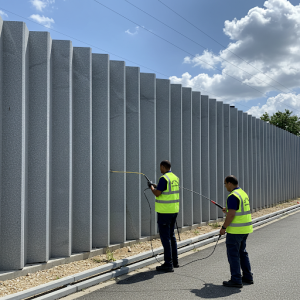
Data collected before and after installation are compared to determine the actual noise reduction achieved. Frequency analysis helps assess if specific noise frequencies have been adequately mitigated. Visual inspections are conducted to identify any gaps or weaknesses in the sound barriers or acoustic treatments.
If necessary, adjustments are made to improve performance, such as adding more material, sealing gaps, or repositioning barriers. Long-term monitoring is recommended to assess the durability and effectiveness of the soundproofing over time, particularly in varying weather conditions. Regular evaluations ensure that the soundproofing continues to meet desired noise reduction targets and complies with relevant regulations. Documentation of test results and any modifications made is essential for future maintenance and potential upgrades.
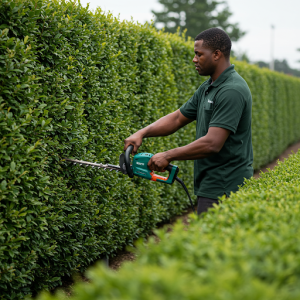
Outdoor soundproofing rules and regulations in Kenya
In Kenya, outdoor soundproofing must adhere to regulations primarily set by the National Environment Management Authority (NEMA). The Environmental Management and Coordination Act (EMCA) and the Noise and Excessive Vibration Pollution Control Regulations of 2009 are key documents. These regulations establish permissible noise levels based on land use, differentiating between residential, commercial, and industrial areas.
Compliance involves ensuring that outdoor noise emissions do not exceed the specified decibel limits. NEMA enforces these standards, and violations can result in penalties. Therefore, when implementing outdoor soundproofing measures, it is crucial to consider these regulations. This includes proper measurement of noise levels, and the application of sound proofing materials in a way that is effective, and that complies with the regulations set forth by NEMA.

